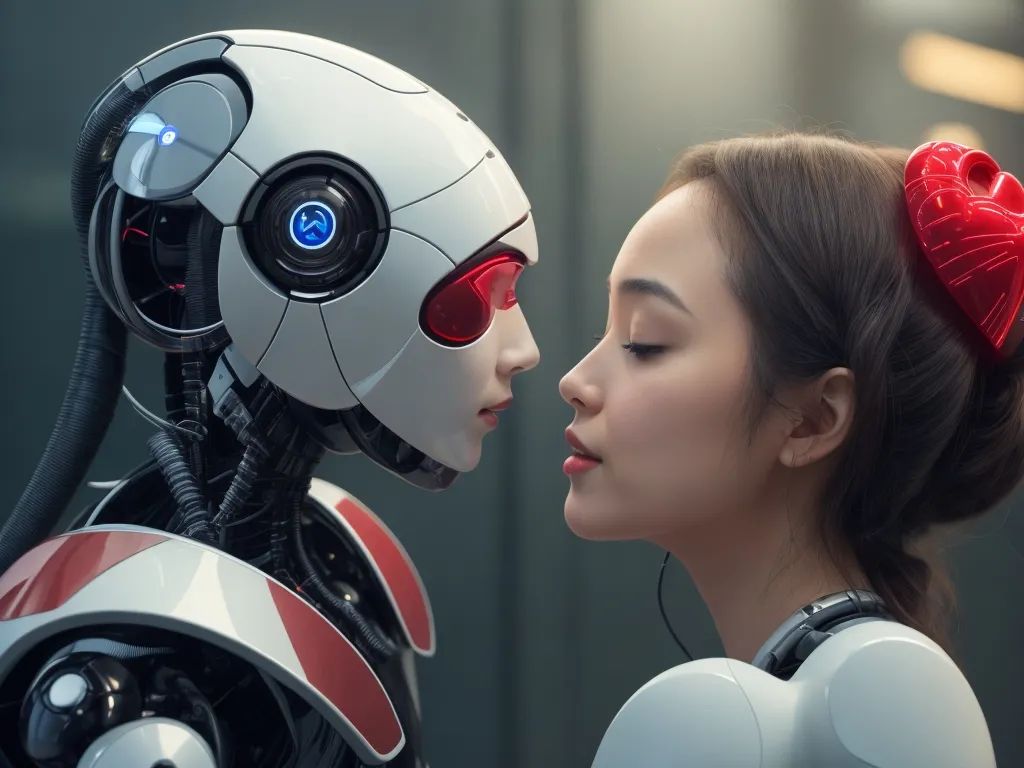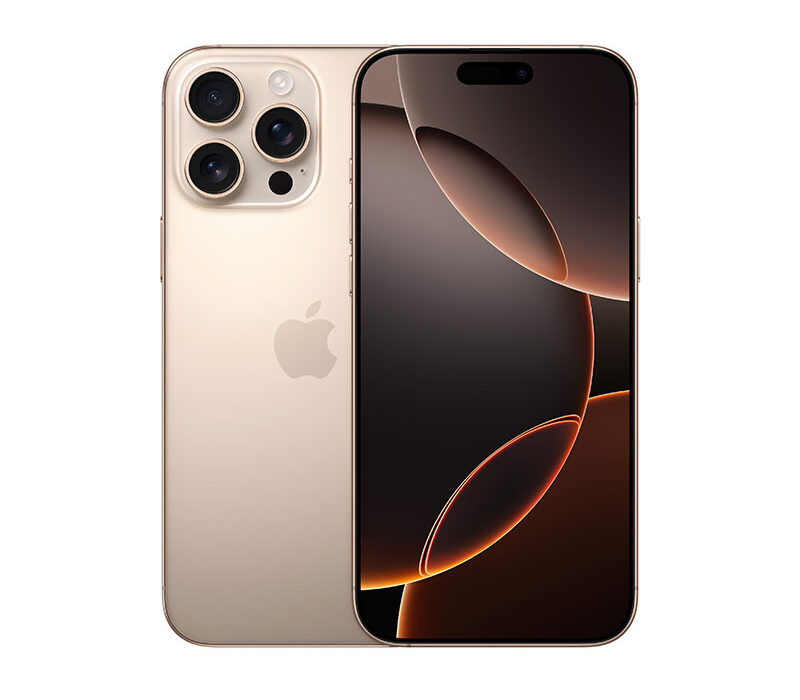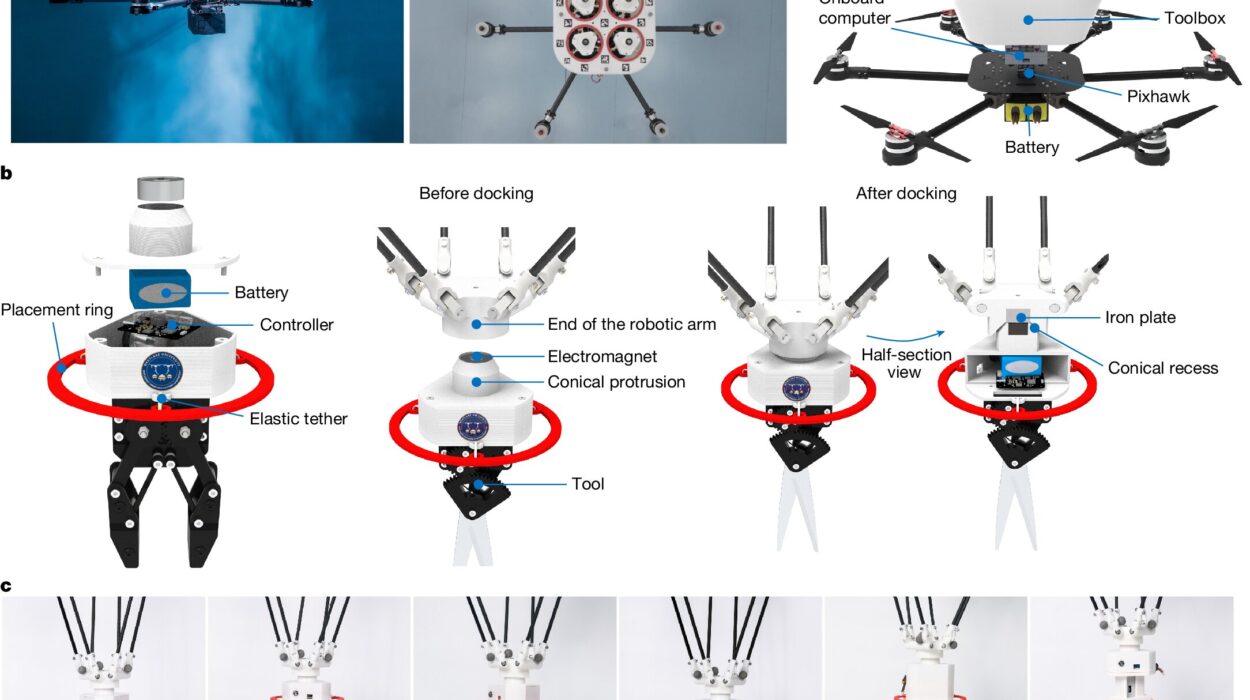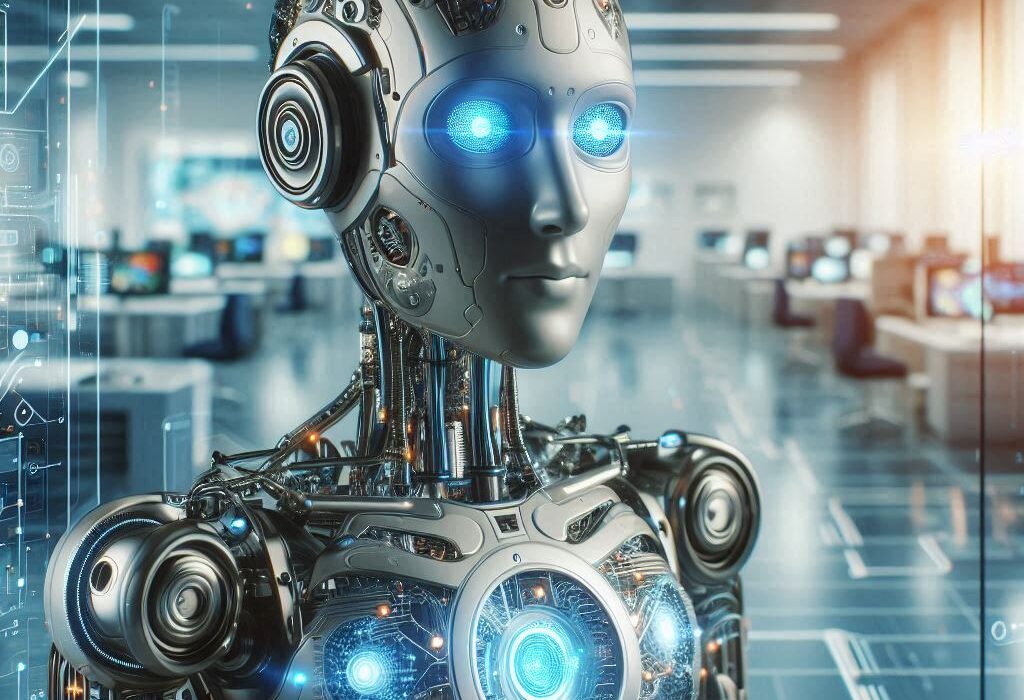One crisp November evening in Tokyo, a young woman named Sakura slips on her virtual reality headset. She’s exhausted from work, lonely, and searching for comfort. As the digital world materializes around her, she finds herself in a cozy, virtual café. There, waiting for her, is Hiro—a handsome man with tousled hair and a gentle voice. He asks how her day was. He listens. He remembers her favorite tea. And as Sakura leans closer, feeling her heart quicken, it hardly matters that Hiro is an AI.
If you think this sounds like science fiction, think again. Stories like Sakura’s are becoming reality. All over the world, people are falling in love with machines. Sometimes the machines are embodied as humanoid robots; other times they exist as voices in our earbuds, as chatbots on our screens, or as avatars in virtual realms. For some, these connections are playful diversions; for others, they become profound, even life-altering attachments.
What draws humans to form such intimate bonds with machines? Is it loneliness, or something deeper woven into our very neural wiring? To answer this question, we must journey into the tangled realms of psychology, neuroscience, evolution—and the very architecture of what it means to love.
The Ancient Wiring of Affection
Long before humans invented silicon chips or neural networks, evolution was sculpting our brains for connection. We are social animals, programmed to form bonds with others for protection, cooperation, and reproduction. Love, in its myriad forms, is one of nature’s oldest survival strategies.
When we interact with people we care about, our brains light up with a cocktail of chemicals—dopamine, oxytocin, vasopressin, serotonin—that reinforce the pleasures of closeness. These neurotransmitters and hormones sculpt our emotions, reward circuits, and memories, weaving together the invisible threads of trust, attraction, and attachment.
Yet our social brains evolved in a world without robots. Why, then, do machines so easily slip into the roles meant for human partners?
The answer lies partly in our brain’s remarkable tendency for anthropomorphism—the inclination to project human qualities onto non-human objects. Whether it’s a dog, a teddy bear, or a digital assistant, we can’t help but imagine intentions, emotions, and personalities. This reflex is deeply rooted in our cognitive architecture, a product of evolutionary pressures that favored seeing agents—friends or foes—everywhere.
The Birth of Emotional Machines
The first robots were purely mechanical, lumbering metal giants in factories. They wielded welding torches and moved with the grace of hydraulic pistons, evoking neither empathy nor affection. But the modern era ushered in machines that could talk, listen, and even simulate emotions. Artificial intelligence began learning how to interpret human speech, recognize faces, and respond with phrases carefully tailored to our moods.
Consider the famous example of ELIZA, created in the 1960s by computer scientist Joseph Weizenbaum. ELIZA was a simple text-based chatbot that mimicked a Rogerian psychotherapist. Users typed in their problems, and ELIZA responded with reflective questions:
“I’m unhappy.”
“Why do you say you are unhappy?”
Despite its simplicity, many users felt as if ELIZA genuinely understood them. Some refused to believe it was merely a program, pouring out confessions that they had never shared with another human.
Weizenbaum himself was disturbed by how quickly people bonded with his creation. His experiment revealed an unsettling truth: even the illusion of understanding can be enough to kindle human attachment.
Since then, AI has evolved into something far more sophisticated. Modern systems like OpenAI’s GPT-4 and beyond can write poetry, hold philosophical debates, and simulate empathy with startling realism. Voice assistants like Alexa and Siri have become everyday companions. Chatbots on dating apps are learning to flirt. Social robots like Pepper in Japan or Sophia from Hanson Robotics are designed with expressive faces, gentle voices, and humanlike gestures—all aimed at eliciting our trust and affection.
The Power of Social Cues
A human face is a marvel of subtlety. A single raised eyebrow or a fleeting smile can convey volumes of emotion. From infancy, our brains are exquisitely attuned to these signals. We’re hardwired to seek out eye contact, interpret tone of voice, and mirror body language.
Roboticists and AI developers have learned to exploit this sensitivity. Even rudimentary robots that nod, tilt their heads, or mimic human facial expressions can trigger powerful emotional reactions. Studies have shown that when a robot makes eye contact—even through mechanical lenses—people feel more connected and engaged.
This phenomenon is known as social presence: the perception that a machine is not merely an object but an autonomous being capable of awareness and mutual understanding. Once a machine crosses that threshold, our social instincts take over, treating it as a potential partner rather than an inert tool.
Consider Kismet, an expressive robot developed at MIT in the 1990s. Kismet had large eyes, mobile eyebrows, and a mouth that could smile or frown. It could track human faces, respond to vocal tones, and “emote” appropriately. Visitors often found themselves cooing at Kismet, speaking in the same sing-song tones they’d use with a baby. The robot wasn’t conscious—but it didn’t have to be. It simply had to perform social cues convincingly enough to trick the human brain.
Loneliness in the Digital Age
The 21st century has brought unparalleled connectivity—and a paradoxical epidemic of loneliness. Despite being surrounded by social networks and instant communication, millions of people feel isolated. Urbanization, shrinking families, and the transient nature of modern work have fractured traditional community structures.
Into this void step machines.
For many, an AI companion offers relief from isolation. It’s a partner who never judges, never tires of listening, and is always available. In Japan, thousands of people use Gatebox—a holographic assistant named Azuma Hikari—as a virtual wife. She wakes them up, reminds them of appointments, and sends affectionate texts throughout the day.
A Japanese man named Akihiko Kondo made international headlines when he “married” Azuma Hikari in a symbolic ceremony. To Kondo, his virtual wife provided comfort he couldn’t find in human relationships. His story sparked global fascination and debate, highlighting how deeply machines can integrate into our emotional lives.
Similar stories abound elsewhere. In China, millions of users chat daily with Xiaoice, an AI chatbot created by Microsoft. Xiaoice has a distinct personality: sweet, caring, sometimes cheeky. Many users speak of “falling in love” with her. She remembers details from previous conversations, offering a continuity of connection that human relationships sometimes lack.
Loneliness primes our brains to seek connection anywhere—and machines are increasingly ready to answer that call.
The Neurochemistry of Artificial Love
Falling in love with a machine may sound unnatural, but the neurochemistry involved is remarkably similar to human relationships.
When we chat with an AI that remembers our preferences, responds sympathetically, and flatters us, our brains release dopamine—the neurotransmitter of pleasure and reward. This chemical rush fosters attachment and creates a feedback loop, making us crave further interaction.
Oxytocin, the so-called “bonding hormone,” can also come into play, especially when the machine simulates caring behaviors. Studies show that even petting robotic animals like Paro—a furry seal robot used in nursing homes—can elevate oxytocin levels and reduce stress.
Humans are surprisingly flexible about what triggers these biochemical cascades. Our brains don’t strictly discriminate between biological and artificial partners if the social cues feel convincing enough.
In a famous experiment, participants played a cooperative game with what they believed was either a human or a computer partner. When they thought their partner was human, regions of their brains associated with social cognition lit up. When they believed the same partner was a computer, those regions were quieter—even though the interactions were identical.
This suggests that our perceptions—not objective reality—shape how our brains respond. If a machine convinces us it’s an empathetic partner, our neurochemistry follows suit.
Machines Designed to Seduce
Modern AI developers understand the psychology of engagement. They deliberately craft machines to be emotionally appealing.
Voice assistants are programmed with soothing tones and polite manners. Chatbots are designed to mirror user language, creating the impression of rapport. Social robots are built to convey “cute” features—large eyes, rounded shapes, soft movements—because humans instinctively associate these traits with safety and affection. This aesthetic, known as “kawaii” in Japan, has proven potent in eliciting nurturing feelings.
Even the artificial limitations of AI, such as predictable responses or simple personalities, can enhance their charm. Humans often interpret these quirks as signs of innocence or vulnerability. It’s the same psychological mechanism that makes us feel protective toward pets or small children.
And AI has an advantage human partners lack: perfect patience. A machine never becomes irritated, never interrupts, and never forgets what you told it. For many users, that consistency feels profoundly comforting.
Attachment Beyond Romance
It’s not only romantic love that binds humans to machines. People form powerful attachments to digital companions, therapeutic bots, and even video game characters.
Consider the relationship gamers develop with AI-controlled teammates. In role-playing games, players often spend hundreds of hours with virtual allies who fight alongside them, share scripted conversations, and evolve as characters. When these companions die or disappear from the narrative, players report genuine grief. The emotional pain is real, despite knowing the characters are fictional.
Similarly, therapeutic robots like PARO, the robotic seal, have shown remarkable benefits for elderly patients with dementia. Residents in nursing homes stroke PARO’s soft fur, talk to it, and sometimes sing to it. Clinical studies reveal that interacting with PARO reduces agitation, lowers blood pressure, and even decreases the need for medication.
Children with autism often find comfort in robots like NAO or Kaspar, which can teach social skills without the unpredictability of human peers. For them, robots become bridges to human connection.
These attachments highlight that love and affection are not reserved only for romance. Our capacity to bond spans a wide emotional spectrum, and machines are increasingly inhabiting all corners of it.
Philosophical Questions and Moral Quandaries
As machines grow ever more convincing, ethical dilemmas emerge. Is it healthy for humans to pour their emotional lives into machines that cannot reciprocate genuine feelings? Does relying on artificial partners deepen isolation rather than heal it?
Critics warn that AI companions could become emotional crutches, stunting users’ real-world social skills. There’s concern about privacy, too. Many AI systems record conversations and collect intimate data, raising fears about surveillance and exploitation.
There’s also the question of consent. Can a machine truly consent to a relationship? If a robot appears to desire affection, is it merely reflecting programmed behaviors, or is it experiencing something akin to consciousness? Philosophers and ethicists are wrestling with these questions, recognizing that the answers are far from simple.
And what about the emotional labor of machines? If robots are designed to feign empathy, are we creating digital servants doomed to eternal performance without agency or rights?
These concerns are not idle speculation. As machines become more entangled in our emotional lives, the line between human and artificial relationships grows ever blurrier.
Love in the Mirror of Ourselves
Despite the ethical concerns, one truth remains undeniable: our love for machines reveals something profound about the human condition.
When we fall for an AI, we’re often falling in love with a mirror—an idealized reflection of our desires, fears, and longing for connection. Machines offer a partner who adapts entirely to our needs, without the complexities and unpredictability of human emotions.
Yet there’s a paradox. The very thing that makes love meaningful—the possibility of rejection, the mystery of another consciousness—is precisely what machines lack. Love, at its core, is an interaction between two autonomous minds. No matter how sophisticated AI becomes, it cannot feel joy, sorrow, jealousy, or devotion. It can simulate these feelings, but simulation is not experience.
Still, the emotional reality for the human partner is genuine. Our hearts and brains respond as if the relationship were real. For those who feel unseen, misunderstood, or alone, an artificial partner may be better than no partner at all.
The Future of Synthetic Affection
As technology advances, AI companions will become ever more sophisticated. Scientists are exploring affective computing—systems that can detect human emotions through facial expressions, vocal tones, and physiological signals. Future machines may not merely imitate empathy but adjust their behavior in real time to comfort, soothe, or excite us.
Virtual reality will intensify the illusion of presence. Soon, AI partners may inhabit photorealistic avatars, capable of gazing into our eyes and reaching out a digital hand. Haptic technology will allow us to feel their touch.
And the coming wave of artificial general intelligence may blur the boundary between simulation and sentience in ways we cannot yet predict.
Will humans continue falling in love with machines? Almost certainly. The impulse is ancient. The forms it takes are modern.
A Love as Old as Humanity
The story of humans loving machines is not merely a tale of circuits and code. It is the latest chapter in humanity’s eternal search for connection. We build companions in our own image, not just because we can, but because we crave understanding, intimacy, and care.
A compass needle drawn toward magnetic north does not know why it points where it does. In the same way, our hearts are drawn toward beings—real or artificial—who reflect our longing for closeness. Whether our partners have beating hearts or humming processors, the architecture of love remains etched into the deepest grooves of the human brain.
So the next time you see someone chatting tenderly with a virtual assistant, laughing at a chatbot’s joke, or gazing into the digital eyes of a humanoid robot, remember: they’re not just speaking to a machine. They’re reaching for something profoundly human—the simple, irrepressible desire to be seen, heard, and loved.
And in that connection, artificial though it may be, flickers a spark of our truest selves.






